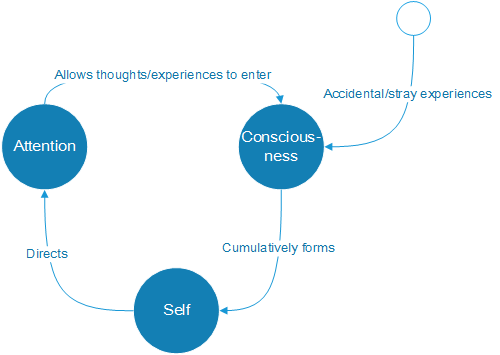These days, I am reading "Flow: The Psychology of Happiness: The Classic Work on How to Achieve Happiness" by Mihaly Csikszentmihalyi. I have felt a natural resonance with Csikszentmihalyi's views since I read The Evolving Self last year, and, unsurprisingly, within a few pages of "Flow", I find a passage that immediately draws me toward diagram-making(a sign of intellectual effervescence!)!
Briefly put, Mr C. (of the unpronounceable name) presents a simple model of consciousness which is "a phenomenological model of consciousness based on information theory". Academic mumbo jumbo? Not so. This simple three-element model is said to be phenomenological, because it deals directly with phenomena (events that we experience and interpret) instead of reducing/distilling them to neurochemical processes. It is said to be based on information theory, because it draws on knowledge about how we process, store, and use "sensory data" a.k.a. our life experiences.
The three-element model begins with consciousness. If we think of being conscious as being able to intentionally order information, being able to manipulate and use information at our will, then there is a quasi-hard limit on consciousness. Let's call a differentiated sound, a given visual stimulus, or a recognizable emotion or thought as a bit of information. Research cited in Flow (a bit dated perhaps, from the early 1990s) claims we cannot hold more than seven bits of information at the same time. Over an assumed life time of seventy years and sixteen hours of waking time per day, we would only be able to process 185 billion bits of information. Let's attempt a conversion of this to the unit for digital information: a human bit might be the equivalent of a small image of perhaps 10 kb, containing a visual stimulus, a sound, etc. Then, the capacity of our lifetime of consciousness is about 1850 TB*. Everything in our life must come from these 1850 TB, every thought, every love, every fear. Therefore, what we spend this given capacity processing, what we pay attention to is what that gives texture to our lives.
*The 1850 TB is not a hard constraint, because there are probably techniques that we can practice, new tricks that we can learn to stretch that limit. Personally, I believe that becoming an expert in a field involves on being able to manipulate larger and larger chunks of information/ideas as a bit, so that one's processing power is many times that of a novice. But, in our day-to-day life, most of us probably function way below this processing capacity limit...
So, back to Mr C., the second element to his model of consciousness starts is our attention. It decides what information passes through our attentional filter to enter our consciousness. He talks of attention as psychic energy. Without it no work can be done, and in doing work it is dissipated. So the most important choices in our lives have to do with how we choose to invest our attention.
The last element of his model is our "self", a most interesting and important element of consciousness. The self is not an ordinary piece of information; it contains everything that has ever passed through consciousness, all the piano lessons, pet peeves, and self-doubts included. The self, thus, is this hierarchy of goals that we have gradually constructed over the years. As babies, we learn to identify the self with our bodies, then, it might include our favourite shirt, a nice car, or an entire ideology.
You see, we are building up a bidirectional causal relationship here: "we" direct our attention to particular thoughts/experiences, which make up the substance of our consciousness; at the same time, our "selves" are the sum of our consciousness. A loop going round and round, chicken and egg, egg and chicken. Typically, when we were young and innocent, accidental experiences -- a fun story book, a hard spanking, a stolen toy --could be incorporated ourselves to become so much more important to our identities. Reading, writing, and modelling are all important aspects of my life that became mainstays through half-accidents. My mom dumped books at me while I was young because it was easier than reading to me; my teenage year morosity found an outlet through my blog and reached a receptive audience; and my first master degree's supervisor just needed someone to code.
The reinforcing ability of this loop can be a scary idea: we can think of echo chambers, of paranoia. This is why, no matter how correct we think we are about how the world works, it might be a good idea to add an element of randomness to what we pay attention to, so that we don't devolve in to self-deluded jerks... But, if harnessed "consciously", the reinforcing ability of the attention-consciousness-self triangle can be a superpower!

